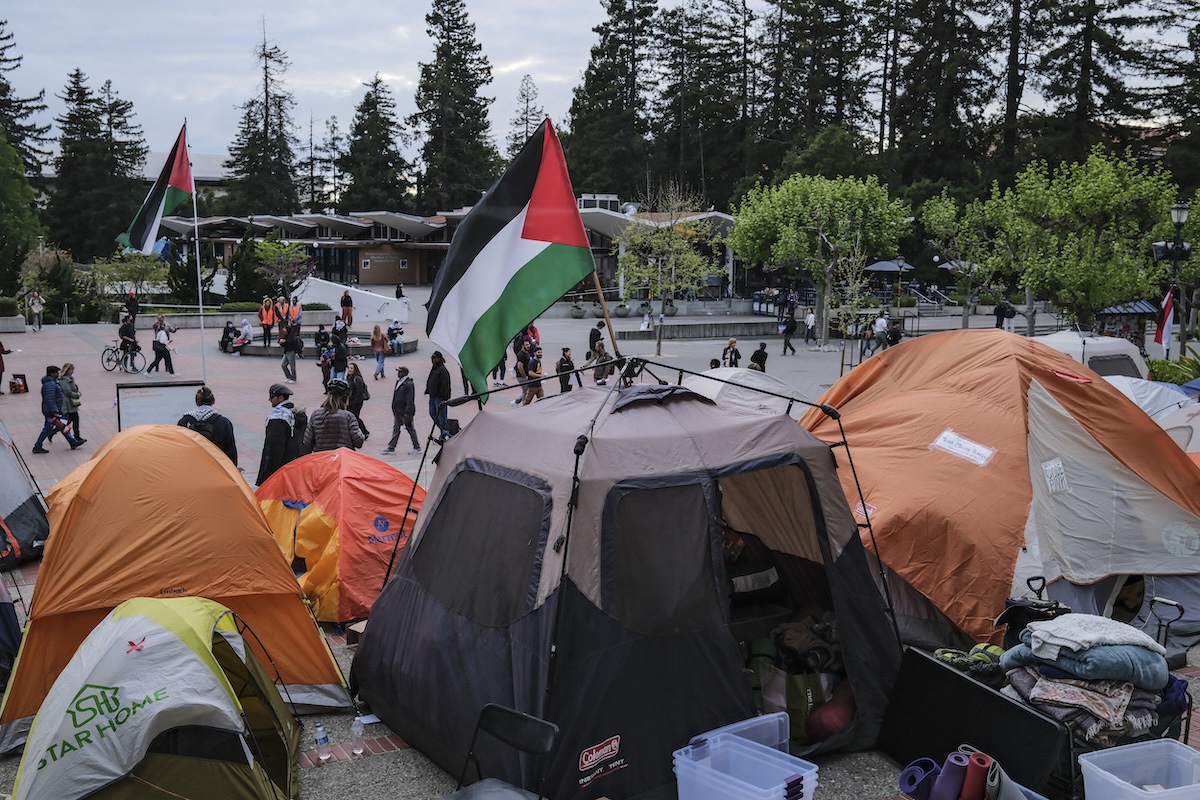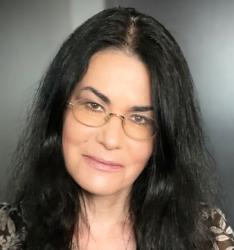The turmoil on American campuses today has nothing to do with free speech. Rather, it uses free speech as an appeal to a Boomer trope—but it’s the wrong trope to use in this case.
Politicians and left-wing opinion leaders criticized the ongoing attempt to dismantle the so-called anti-Zionist encampments established at multiple universities as an unjustified attack on peaceful protest. For instance, U.S. Congresswoman Rashida Tlaib sounded out against law enforcement: “Sending in militarized police and snipers to stop students from exercising their First Amendment rights is truly disgusting.”
With that in mind, it’s worth revisiting the origins of the University of California, Berkeley original Free Speech Movement. It sprang up in 1964 and inspired multiple acts of civil disobedience both on and off college campuses. It was one of the iconic events that formed the countercultural aura of the 1960s.
The impetus was the university restriction that limited political fundraising to the Republican and the Democratic clubs on campus. When an outside agitator was arrested for vending an unauthorized table that solicited donations for civil rights causes, the movement immediately crystallized around his release, the relaxation of restrictions on activism, and—for good measure—faculty loyalty oaths.
Although the free speech leaders were all on the left, students across the political spectrum supported the movement’s agenda; the silent majority was dissatisfied with the way the regents ran the campus. The very modest goals of the movement were quickly met, but many of the activists, both seasoned and newly baked, found it difficult to go back to normal life. Their work attracted like-minded individuals, snowballing into antiwar activism and, eventually, their greatest material achievement—the occupation of an empty university lot a few blocks south of campus. They took over the land, planted a few bushes, and renamed it People’s Park. When the university demanded its property back, they called up 6,000 men for a riot.
Ronald Reagan sent in the National Guard to quell it, but the university regents lost their will and abandoned the parcel to the activists. Those who were homeless in the area were invited to keep the place warm in case the regents changed their mind—and they stayed there, turning the entire Southside into a ’60s theme park, complete with drugs, criminality, and mad-as-hatters street personalities. It went on, remarkably, until fall 2023, when the unhoused were finally evicted to permit construction of a new dorm. To keep the encampment from coming back, the area had to be fenced in by shipping containers stacked on top of each other.
The demise of People’s Park signals the declining power of white Boomer radicals—the new revolution has bypassed them. The story is interesting as a cautionary tale regarding “encampments” and because, while the cult of the Free Speech Movement (FSM) became institutionalized in Berkeley, which built monuments and names cafés after it, free speech itself is hardly the reality there today.
When I was a student at Berkeley in the 1990s and the early 2000s, at a midpoint between the ’60s and today, Sproul Plaza, the area where the FSM unfolded, could best be described as a free speech carnival. Street personalities gave performances, drawing large crowds of gawkers looking for comic relief on the way to class. Multiple organizations fielded tables there, and large rallies were held—with students from the nearby Oakland Unified bussed in for better diversity optics.
Freedom of expression was over the top even among the normies; in-your-face self-expression was considered the Berkeley heritage. Undergrads running for student government formed silly-sounding parties, occasionally dressing in outrageous outfits. A couple of girls called themselves the Two Hot Chicks Party. There was a dude who agitated to “Vote for Frankenstein—he is no monster!” It was pronounced Frankensteen (and I think I might have voted for him). The “seriousness” of that enterprise aside, even though conservatives got shot down regularly, the student body in the mid-’90s was generally committed to the free exchange of ideas, meeting new people, and a willingness to consider opposing viewpoints.
Significant changes took place in American society during Barack Obama’s second term, however, and opposition to free speech went into overdrive after the election of Donald Trump in 2016. In Berkeley, fraternity brothers were assaulted and spat on, and speeches by undesired speakers—Jews and conservatives—inspired violent demonstrations, leading to cancellations. Loyalty oaths have returned in the form of DEI statements. Campus speech is restricted by codes enforced by the administration and the faculty in addition to peer pressure from zealous teens raised to believe that the First Amendment is not absolute. In the past few years, admission has been awarded on the basis of essays and likely went to the types best judged to fit in with campus politics.
Although free speech is evoked by the supporters of the current campus jihad, to subscribe to that opinion one has to ignore a large body of evidence coming from the movement itself. Sure, the anti-Israel protesters invite controversial speakers like the unrepentant domestic terrorist Bill Ayers of Weather Underground to give talks—but that’s permitted speech from their perspective. The people glamping in these encampments, however, don’t want to talk to the media; in fact, sometimes their posted rules prohibit them from doing so, insisting instead that journalists be directed to their leaders. They eject, often violently, the journalists and ordinary citizens who dare to record them. In one case, they stole a journalist’s equipment.
If free speech on campus has done a 180 since the early ’60s, the left-wing “protest” strategy picked up where People’s Park left off. People’s Park illegally took over a small plot of land that the regents held on behalf of the citizens of California. Something similar happened in the summer of 2012 with the Occupy movement. That time, young people, self-consciously LARPing the 1967 Summer of Love, spread their tents across public and private properties around the country, demanding economic equity. The copycat Summer of Love ended up as did the original one—as a drug-fueled rape orgy. Eventually the cops took down the encampments and the kids went home.
At about the same time, homeless nonprofits started supplying the unhoused with tents, making their growing presence more visible on city streets. Places like San Francisco are particularly bad—here, nonprofits are required to practice harm reduction, which amounts to keeping an addict alive long enough for him to decide to quit instead of forcing him into rehab. San Francisco’s citizen journalist Adam Mesnick compares harm reduction to hospice—it’s a matter of quick deterioration on the way to sure death.
Tents—and later campers provided by the state of California—are a part of harm reduction. They make the addict comparatively comfortable and even make some of the nastiest aspects of his disease less visible. But they continue to remain an aggressive presence around our cities, obstructing sidewalks, limiting options for local restaurants, and violating quite obviously the Americans with Disabilities Act. They have been normalized since Occupy—People’s Park gone national. The homeless themselves may be apolitical, but their NGO handlers are cued in with the progressive establishment.
The favorite tactic of the Black Lives Matter (BLM) movement, which popped up after Occupy withered away, is the illegal blocking of freeways and bridges to broadcast political messages. The tactic was immediately picked up by other far-left groups, most notably the environmentalists. Just like political claiming of spaces was passed on to ostensibly apolitical fentanyl addicts, thrill-seeking side shows muddied the waters for BLM, making road takeovers part of normal weekend nights in cities like Oakland. Because he who controls the roads controls the country, erecting illegal roadblocks on freeways is a warlording move that shouldn’t be tolerated.
The Liberate movement on campus—the language having shifted 180 degrees from the 2012 Occupy—combined the tactics of both the second Summer of Love and BLM’s many summers of hate, and moved them a notch. “Anti-Zionists” claim territory with tents, sometimes placing them in lobbies, where they are not needed. They immediately transformed their settlement into a closely guarded territory, barring passage to undesirables. They are trying out the new tactic of locking arms and crowding in on “intruders,” forcing them out of the settlement. Occasionally, the liberators/occupiers go further than that—in one video, after running off a Jewish student from what was once, and still legally remains, a common area, the “anti-Zionists” were seen asking where the Jews are around the campus.
Many police departments across the country have been reduced in size and don’t have the resources to play the cat-and-mouse game—you know, they clean up the encampment only to watch it come back after the law breakers are swiftly released from custody. In Berkeley, the decision was to leave the very modest-size encampment in place despite the physical violence directed at Jews there. Is it going to stay there for 50 years, like People’s Park?
The good news is that while the tactics used by this movement—claiming territory, barring access, and chasing off the undesirables—represent an escalation, the movement is pathetically small. On one hand, it lacks charisma. The ’60s protest movement had an enduring popular appeal; even if it lost politically in the short run, it planted seeds in our culture that eventually blossomed into nostalgia for a clear political agenda. But if Occupy was able to capitalize on it, campus intifada is full of less-than-charming women who shriek hysterically and cover up with masks. Although their lives appear to be devoid of family and faith, the UCLA protesters nevertheless found it possible to imitate Islamic prayer and chant Allahu Akbar. Their posted rules apparently include no sex and no substances; the movement is crying out for its Timothy Leary.
Moreover, the very fact this campus intifada is tightly controlled makes it difficult to grow in size. When your greeting says, “Welcome to the liberated zone! Make sure to talk to one of us before entering,” you are probably going to repel more than a few free spirits. Even the like-minded can be disgusted with the creepiness of the encampments. Walking arm-in-arm is probably not for everyone. Not to mention that most Americans are not too terribly interested in Gaza, and those who know a thing or two about it tend to be pro-Israel.
In sum, we are using a wrong ’60’s analogy when discussing these protests. Under the cover of “free speech,” a dark and much more illiberal People’s Park is alive and well on campuses. The organizers are experimenting with ways to engineer widespread political upheaval, combining and gradually escalating tactics. Our gutted law enforcement and gutless schools unwilling to expel the law-breaking students are incapable of dealing with pressure.
On the other hand, communist activists are well-healed and organized. They dedicated their lives to strategizing against the United States. One day, they might just come up with a winning idea.

